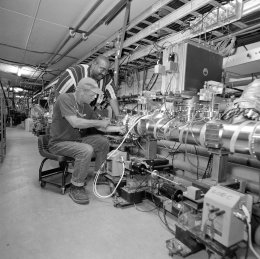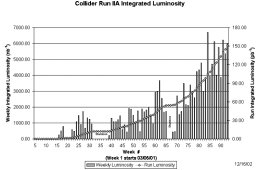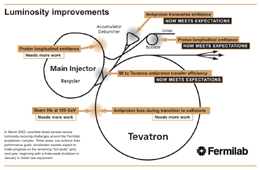 |
|
Physics Driver
by Kurt Riesselmann
When you drive your car along a highway, you probably don’t think too much about all the things that need to function properly:the pistons moving up and down, the gasoline flowing into the fuel chamber, the spark plugs firing at the right time. Likely, you just get into your car, start the engine, put it in gear — and go. The driving done by Fermilab’s accelerator operators is far from being that simple. It requires five years of training. Instead of gears, operators engage a chain of increasingly more powerful accelerators. Instead of combustion engines, they monitor the energy provided by powerful “microwave ovens.” And instead of 65 miles per hour, they accelerate particles close to the speed of light. “There are 66,000 parameters that we can control,” said Bob Mau, head of Fermilab’s Accelerator Operations department.“If not set properly, every single one can effect beam operation,perhaps terminating a store.” Store is Fermilab’s technical jargon for a large number of particles doing laps inside the Tevatron ring,the world’s highest-energy accelerator. During a store, protons and antiprotons race through the Tevatron tunnel in opposite directions, with the speedometer showing an impressive 670 million miles per hour. Physicists use the two particle beams to initiate powerful head-on collisions to learn more about the building blocks of matter and their role in the evolution of the universe. To get the best performance, accelerator experts constantly tune their particle machines. In the past six months Fermilab accelerators have broken several performance records. But you won’t hear the physicists talk about “horsepower” or “revolutions per minute.” Instead, they get excited about “inverse picobarns,” a measure for integrated luminosity, the number of collisions recorded during a store.
During the second week of October, beam experts achieved an all-time Tevatron record of 6.7 inverse picobarns in a single week, more than a factor four larger than the weekly integrated luminosity twelve months ago. They also set several all-time records for the highest peak luminosity,with a current top value of 3.7 x 10-5 inverse picobarns per second. “Over the past year, we’ve investigated over fifty ideas to improve the Tevatron performance,” said Vladimir Shiltsev, the head of the Tevatron Department.“Five attempts were really successful, resulting in major improvements. Ten attempts were so-so, and the others didn’t fly. It is a continuous search.” During 2002, scientists and engineers have carefully studied and adjusted subsets of the 66,000 accelerator parameters to increase beam luminosity, improving the rate of collisions. In March, a graphic published in FERMINEWS explained the troubles beam experts had identified at that time (FERMINEWS ,March 1,2002,Vol.25, No.4). The updated version (see graphic on page 4) shows that scientists have corrected many of them. “At the beginning of the year, we still had large problems with transfer efficiencies, getting particles from their point of production through several stages of acceleration into the Tevatron,” Shiltsev said.“These problems have largely been resolved.” Fermilab’s antiprotons, for example, travel through three different accelerators before arriving at the Tevatron. Each transfer from one accelerator to another is comparable to transferring water from a container into an empty bottle using a garden hose. If the diameter of the hose is larger than the opening of the bottle,a lot of water will be spilled, resulting in low transfer efficiency. Repeating the inefficient transfer process several times,pouring the water from one bottle into the next, the losses quickly add up. If the bottles have leaks, the total efficiency drops even more. Handling antiprotons, arguably the most precious particles on earth, scientists try to minimize losses as much as possible. “In March, we saw a total efficiency of 30 percent in getting particles to the collision point,” said the deputy head of the Beams Division, Mike Church, recalling the problematic performance of the accelerator complex at the beginning of the year. “Now we are at 70 percent, which is better than during Run I. Our goal is 80 percent.”
Collider Run I ended in 1996. During the next five years, scientists and technicians upgraded Fermilab’s accelerator complex. The construction of a new “switchyard accelerator,” called the Main Injector, was equivalent to installing a new transmission in a car. On March 1,2001, Run II began. It took more than a year to work out the kinks of the upgraded accelerator complex. In the summer of 2002, for example, technicians installed additional equipment in the Accumulator, an accelerator ring that stores antiprotons. “It was like doing open-heart surgery on the Accumulator,” said Dave McGinnis, head of the Antiproton Source group.“We carried out two extremely ambitious projects. They allowed us to reduce the antiproton beam size by about a factor two and a half, leading to an increased transfer efficiency.” Because of better beam cooling equipment and reprogrammed particle trajectories, scientists now manage to transfer more antiprotons from the Accumulator to the Main Injector, from which the particles are sent to the Tevatron. Also, the rate of antiproton production is now 30 percent higher than at the beginning of the year, almost twice the rate of Run I. “In a typical store we now have a factor four more antiprotons in the Tevatron than in December 2001,” said Tevatron department head Shiltsev. Delivering more particles to the Tevatron is only the first — although most important — step in improving the luminosity. At present,too many particles — both protons and antiprotons — are lost while circling the four-mile Tevatron ring. “We see a stability problem in the Tevatron,” said Church. “The beam oscillates in an uncontrolled fashion and as a result the beam size increases. In addition, the proton beam has a lifetime problem. We lose protons while the antiprotons get loaded. The long-range beam-beam effect is still an issue.” To minimize the influence of the positively-charged protons on the negatively-charged antiprotons, and vice versa, scientists try to separate the two beams from each other as much as possible. The limited size of the Tevatron beam pipe, in places less than two inches in diameter, severely restricts how far the two beams, which twist around each other by following the lines of a double helix, can be separated. Reducing the thickness of each beam —its emittance — is a key factor in reducing beam- beam effects.
“Now it’s more about beam quality, not quantity,” Shiltsev said.“We have about seventy people working on the Tevatron issues, equivalent to thirty- six fulltime employees. This is two times more than a year ago.” To improve the accelerators, beam experts and operators work hand in hand. “Because of the amount of changes in the operations of the Tevatron, we frequently have the beam experts in the Main Control Room,” said Mau, who supervises the operators in the MCR. “When they make a change they want to observe what is happening. When they deem the change operational, they give the operators the control.” Duane Newhart, who’s worked for six years as an accelerator operator and who is now a crew chief, agreed. “It meshes pretty nicely when the experts are in the control room,” he said.“It’s a team effort. They tell us what they want changed and why, and we make the changes they ask for. Typically, we will still do the driving.” Although the Fermilab accelerators aren’t yet the nicely tuned racecar that everyone is hoping for, beam experts have produced a reliable sedan. If things continue to improve, Fermilab could enter the Formula One circuit in 2003.
ON THE WEB:
|


